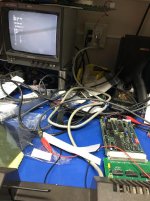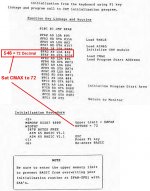Hugo Holden
Veteran Member
I have successfully made a working replica of the Rockwell RM-65 CRTC video card and the Adapter card to make it work with the AIM-65.
I had no idea how good this CRTC card was, until I read the user manual, all sorts of options for video formats, but even better, a large section of the firmware, on the on-board ROM, is dedicated to supporting its function with the AIM-65 computer. So it doesn't use any of the AIM-65's processor time, required by other video cards requiring a software protocol to run.
Out of all of the vintage computer replica cards I have made so far, this one was by far and away the most challenging, because it is a 4 layer board. I had to create the invisible 2 layers and in one of those layers is an 8 bit data bus. It stretched me and my pcb maker to the limit and took some months to finish. It would not have been possible without help from member dfnr2 who provided photos & X-rays of the original board, and importantly, the ROM dumps. Thank you.
Now it is working, it was all worth it.
I have attached some images, using it with BASIC on the AIM-65. Interestingly, much like the dilemma with BASIC pointers that was recently solved to allow BASIC on the AIM 65 to run a Commodore 1541 disk drive, with the AH5050 system (INIBAS PROGRAM), to operate this card with BASIC running in the AIM-65, some pointers in memory need changing. But in this case, it was no mystery, because Rockwell explained how to do it in the CRTC user manual, otherwise it would have been awkward for me because my strengths are only on the hardware side of the technical challenge and I struggle with the software.
I am doing up a very detailed article on it, I will add the link to this thread when it is ready.
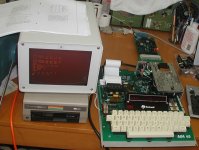
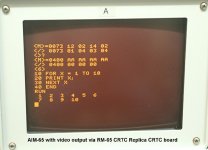
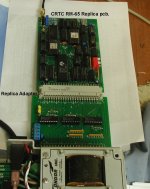
I had no idea how good this CRTC card was, until I read the user manual, all sorts of options for video formats, but even better, a large section of the firmware, on the on-board ROM, is dedicated to supporting its function with the AIM-65 computer. So it doesn't use any of the AIM-65's processor time, required by other video cards requiring a software protocol to run.
Out of all of the vintage computer replica cards I have made so far, this one was by far and away the most challenging, because it is a 4 layer board. I had to create the invisible 2 layers and in one of those layers is an 8 bit data bus. It stretched me and my pcb maker to the limit and took some months to finish. It would not have been possible without help from member dfnr2 who provided photos & X-rays of the original board, and importantly, the ROM dumps. Thank you.
Now it is working, it was all worth it.
I have attached some images, using it with BASIC on the AIM-65. Interestingly, much like the dilemma with BASIC pointers that was recently solved to allow BASIC on the AIM 65 to run a Commodore 1541 disk drive, with the AH5050 system (INIBAS PROGRAM), to operate this card with BASIC running in the AIM-65, some pointers in memory need changing. But in this case, it was no mystery, because Rockwell explained how to do it in the CRTC user manual, otherwise it would have been awkward for me because my strengths are only on the hardware side of the technical challenge and I struggle with the software.
I am doing up a very detailed article on it, I will add the link to this thread when it is ready.




